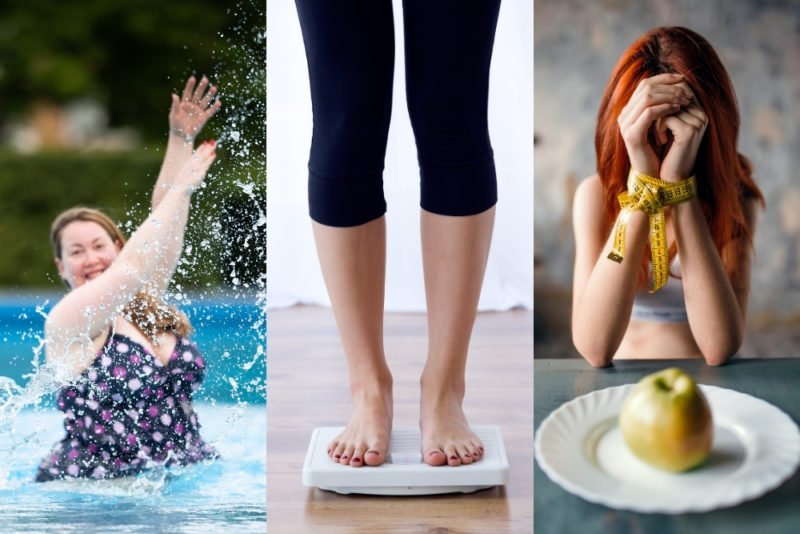
As tempting as it is to imagine that life falls neatly into categories, this sort of black-or-white, all-or-nothing thinking does not reflect the fact that life is, if not messy, at least existing on a spectrum or continuum. That’s no less true with how we relate to our body weight, our food, and how we move our bodies. Each of is somewhere on a HAES-dieting-eating disorders spectrum.
On one end of the spectrum is a Health at Every Size (HAES) approach (i.e., an approach to health that doesn’t focus on weight). On the other end is eating disorders, specifically restrictive eating disorders like anorexia. In the middle, we have dieting. As you read the descriptions, see if anything surprises you.

Body weight
How much does weight matter? Do we need to push our bodies into a lower weight (or prevent weight gain if we are already at a lower weight) to be healthy? Do we need to be at a lower weight to feel that we are acceptable or worthy? Or is the size of our body symbolic of something more? Let’s take a brief look of what determines weight across the spectrum:
- HAES: Weight is based on the body’s natural inclination to settle in its natural set “range” (in other words, not a set “point”). Weight is simply one of our characteristics – like shoe size, height or eye color – and not something associated with our value as a human being or a measure of our intelligence, discipline or aptitude.
- Dieting: Weight is based on our intentional actions and behaviors in response to external cues such as body mass index (BMI), body composition, weight graphs and charts. The weight we strive for – and the actions we take to try to get there – is based on what society says is a “good” or “acceptable” weight – in other words, how close we are to meeting the “thin ideal.” This may involve regular weighing.
- Eating disorder: Weight is based on our intentional actions and behaviors response to cues such a desired degree of thinness (or even “invisibility”) and the psychological aspects of the disease. This may involve obsessive weighing and a feeling that the weight is never low enough. The person may base their worth on their weight to a more heightened degree to what we see with dieting.

Relationship with food
Ideally, food is a source of both fuel and fun. It nourishes our bodies and provides sensory pleasure. But as you can see below, that’s not always the case.
- HAES: Permission to eat is unconditional, with no foods “off the table.” Eating is in response to natural cues of hunger and satiety/fullness. Choices are based on what foods sound good, feel good and will be satisfying. Intake of food and nutrients is effortlessly and unintentionally balanced. Food is just one part of life.
- Dieting: Permission to eat is conditional, based on current weight and possibly on other food rules (such as “clean eating”). Food choices are based on beliefs about what person “should” and “shouldn’t” eat. The dieter has a very careful approach to eating, and meals are regimented, often missing “fun” foods. Food is a major focus in life.
- Eating disorder: Permission to eat is conditional, based on strict food rules. Food choices are based on “good” and “bad” foods. The eating experience is often laden with fear and anxiety, and food intake may be chaotic or overly controlled, and is often ritualistic. Food is THE focus in life. Controlling food may be a way to have SOME control in a life that feels chaotic.

Exercise / physical activity / movement
Our bodies are designed to move, and staying active is one of the best things we can do for our health and well-being. But as with many things, mindset matters, as does the dose. Too much of a good thing can become a bad thing, especially when we use a stick rather than a carrot to motivate us. Let’s look at the differences:
- HAES: Joyful movement, motivated by what feels good to both body and mind. Amount or types of activity is not dictated by food intake or weight.
- Dieting: Purposeful movement motivated by need to maintain or lose weight. Amount or types of activity may fluctuate based on food intake.
- Eating disorder: Dutiful, fear-based, compulsive, punishing or addictive movement, motivated by need to compensate for or allow food intake, as well as to sculpt the body. Amount or types of activity is strongly connected to food intake.

Overall perspective / philosophy
Weight, food and movement don’t exist in their own little silos. Our attitude, feelings and beliefs about one generally colors our perception of the others. Here’s a brief summary:
- HAES: Total allowance for the body to be at its natural weight, as determined by normal, intuitive eating.
- Dieting: Focused on a desired weight with the hope that that can be achieved and maintained with regimented eating.
- Eating disorder: Resistant to reaching and/or maintaining a healthy weight, even though current weight and food intake may be low enough to not be compatible with life.

What did you notice?
Now that you’ve read about the HAES-dieting-eating disorders spectrum, what surprised you? What made you say, “Yes, this is true” (either through your own experience or observations of those close to you)? Did anything disturb you?
One thing that sort-of-but-not-really surprises me every time I write about this topic is the similarities between “dieting” and “eating disorder,” especially when you look at factors like:
- Frequency of weighing (or otherwise measuring the body)
- Food rules
- Feelings that thinness equals worthiness
- Attempts to control the body
- Obsession with what you’re eating, what you just ate, and what you will eat
- The lack of joy in food or movement
While I looked at three points on the spectrum in this post, I see a lot of the space in between in my clients, in society, and in myself once upon a time! I have many clients who had engaged in dieting practices so strict and obsessive that they bordered on eating disorder territory (I was there once, myself). I have many clients who come to me starting to embrace a mindset and behaviors that are compatible with Health at Every Size, but they still have one foot in the dieting camp – or they feel like they can only “do HAES” if their weight isn’t “too high.”
It’s those middle areas that can be especially confusing. I remember being in the middle of my last major diet a decade ago, feeling on the one hand really superior and victorious and worthy (and compliant with societal norms), but on the other hand starting to suspect that something was wrong, and that what I was doing was verging on dangerous territory.
Thank goodness I’m not wired for developing an eating disorder, and thank goodness I listened to that little voice inside me!
Where are you on the spectrum?
Carrie Dennett, MPH, RDN, is a Pacific Northwest-based registered dietitian nutritionist, journalist, intuitive eating counselor, author, and speaker. Her superpowers include busting nutrition myths and empowering women and men to feel better in their bodies and make food choices that support pleasure, nutrition and health. This post is for informational purposes only and does not constitute individualized nutrition or medical advice.
Seeking 1-on-1 nutrition counseling? Learn more about her Food & Body, IBS management, and nutrition counseling programs, and book an intro call to see if the program is a good fit, and if we’re a good fit!
Want exclusive content on nutrition, health, diet culture and more, plus critiques of nutrition and health journalism? Subscribe to my Food Noise newsletter! 📣






